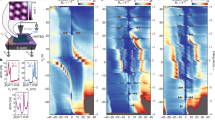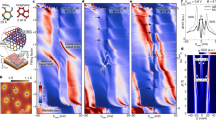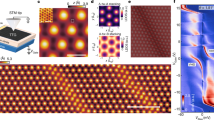Abstract
Interactions among electrons create novel many-body quantum phases of matter with wavefunctions that reflect electronic correlation effects, broken symmetries and collective excitations. Many quantum phases have been discovered in magic-angle twisted bilayer graphene (MATBG), including correlated insulating1, unconventional superconducting2,3,4,5 and magnetic topological6,7,8,9 phases. The lack of microscopic information10,11 of possible broken symmetries has hampered our understanding of these phases12,13,14,15,16,17. Here we use high-resolution scanning tunnelling microscopy to study the wavefunctions of the correlated phases in MATBG. The squares of the wavefunctions of gapped phases, including those of the correlated insulating, pseudogap and superconducting phases, show distinct broken-symmetry patterns with a √3 × √3 super-periodicity on the graphene atomic lattice that has a complex spatial dependence on the moiré scale. We introduce a symmetry-based analysis using a set of complex-valued local order parameters, which show intricate textures that distinguish the various correlated phases. We compare the observed quantum textures of the correlated insulators at fillings of ±2 electrons per moiré unit cell to those expected for proposed theoretical ground states. In typical MATBG devices, these textures closely match those of the proposed incommensurate Kekulé spiral order15, whereas in ultralow-strain samples, our data have local symmetries like those of a time-reversal symmetric intervalley coherent phase12. Moreover, the superconducting state of MATBG shows strong signatures of intervalley coherence, only distinguishable from those of the insulator with our phase-sensitive measurements.
This is a preview of subscription content, access via your institution
Access options
Access Nature and 54 other Nature Portfolio journals
Get Nature+, our best-value online-access subscription
$29.99 / 30 days
cancel any time
Subscribe to this journal
Receive 51 print issues and online access
$199.00 per year
only $3.90 per issue
Buy this article
- Purchase on Springer Link
- Instant access to full article PDF
Prices may be subject to local taxes which are calculated during checkout





Similar content being viewed by others
Data availability
The data that support the findings of this study are available from the corresponding author upon reasonable request.
Code availability
The code that supports the findings of this study is available from the corresponding author upon reasonable request.
References
Cao, Y. et al. Correlated insulator behaviour at half-filling in magic-angle graphene superlattices. Nature 556, 80–84 (2018).
Cao, Y. et al. Unconventional superconductivity in magic-angle graphene superlattices. Nature 556, 43–50 (2018).
Yankowitz, M. et al. Tuning superconductivity in twisted bilayer graphene. Science 363, 1059–1064 (2019).
Lu, X. et al. Superconductors, orbital magnets and correlated states in magic-angle bilayer graphene. Nature 574, 653–657 (2019).
Oh, M. et al. Evidence for unconventional superconductivity in twisted bilayer graphene. Nature 600, 240–245 (2021).
Sharpe, A. L. et al. Emergent ferromagnetism near three-quarters filling in twisted bilayer graphene. Science 365, 605–608 (2019).
Serlin, M. et al. Intrinsic quantized anomalous Hall effect in a moiré heterostructure. Science 367, 900–903 (2020).
Nuckolls, K. P. et al. Strongly correlated Chern insulators in magic-angle twisted bilayer graphene. Nature 588, 610–615 (2020).
Xie, Y. et al. Fractional Chern insulators in magic-angle twisted bilayer graphene. Nature 600, 439–443 (2021).
Călugăru, D. et al. Spectroscopy of twisted bilayer graphene correlated insulators. Phys. Rev. Lett. 129, 117602 (2022).
Hong, J. P., Soejima, T. & Zaletel, M. P. Detecting symmetry breaking in magic angle graphene using scanning tunneling microscopy. Phys. Rev. Lett. 129, 147001 (2022).
Kang, J. & Vafek, O. Strong coupling phases of partially filled twisted bilayer graphene narrow bands. Phys. Rev. Lett. 122, 246401 (2019).
Bultinck, N. et al. Ground state and hidden symmetry of magic-angle graphene at even integer filling. Phys. Rev. X 10, 031034 (2020).
Lian, B. et al. Twisted bilayer graphene. IV. Exact insulator ground states and phase diagram. Phys. Rev. B 103, 205414 (2021).
Kwan, Y. H. et al. Kekulé spiral order at all nonzero integer fillings in twisted bilayer graphene. Phys. Rev. X 11, 041063 (2021).
Tarnopolsky, G., Kruchkov, A. J. & Vishwanath, A. Origin of magic angles in twisted bilayer graphene. Phys. Rev. Lett. 122, 106405 (2019).
Song, Z.-D. & Bernevig, B. A. Magic-angle twisted bilayer graphene as a topological heavy fermion problem. Phys. Rev. Lett. 129, 047601 (2022).
Liu, X. et al. Visualizing broken symmetry and topological defects in a quantum Hall ferromagnet. Science 375, 321–326 (2022).
Coissard, A. et al. Imaging tunable quantum Hall broken-symmetry orders in graphene. Nature 605, 51–56 (2022).
Blason, A. & Fabrizio, M. Local Kekulé distortion turns twisted bilayer graphene into topological Mott insulators and superconductors. Phys. Rev. B 106, 235112 (2022).
Wagner, G., Kwan, Y. H., Bultinck, N., Simon, S. H. & Parameswaran, S. A. Global phase diagram of the normal state of twisted bilayer graphene. Phys. Rev. Lett. 128, 156401 (2022).
Lake, E., Patri, A. S. & Senthil, T. Pairing symmetry of twisted bilayer graphene: a phenomenological synthesis. Phys. Rev. B 106, 104506 (2022).
Khalaf, E., Chatterjee, S., Bultinck, N., Zaletel, M. P. & Vishwanath, A. Charged skyrmions and topological origin of superconductivity in magic-angle graphene. Sci. Adv. 7, eabf5299 (2021).
Kozii, V., Isobe, H., Venderbos, J. W. F. & Fu, L. Nematic superconductivity stabilized by density wave fluctuations: possible application to twisted bilayer graphene. Phys. Rev. B 99, 144507 (2019).
Christos, M., Sachdev, S. & Scheurer, M. S. Superconductivity, correlated insulators, and Wess–Zumino–Witten terms in twisted bilayer graphene. Proc. Natl Acad. Sci. USA 117, 29543–29554 (2020).
Wong, D. et al. A modular ultra-high vacuum millikelvin scanning tunneling microscope. Rev. Sci. Instrum. 91, 023703 (2020).
Kerelsky, A. et al. Maximized electron interactions at the magic angle in twisted bilayer graphene. Nature 572, 95–100 (2019).
Choi, Y. et al. Electronic correlations in twisted bilayer graphene near the magic angle. Nat. Phys. 15, 1174–1180 (2019).
Jiang, Y. et al. Charge order and broken rotational symmetry in magic-angle twisted bilayer graphene. Nature 573, 91–95 (2019).
Rutter, G. M. et al. Scattering and Interference in epitaxial graphene. Science 317, 219–222 (2007).
Pásztor, Á. et al. Holographic imaging of the complex charge density wave order parameter. Phys. Rev. Res. 1, 033114 (2019).
Farahi, G. et al. Broken symmetries and excitation spectra of interacting electrons in partially filled Landau levels. Preprint at https://arxiv.org/abs/2303.16993 (2023).
Wong, D. et al. Cascade of electronic transitions in magic-angle twisted bilayer graphene. Nature 582, 198–202 (2020).
Yu, J. et al. Spin skyrmion gaps as signatures of intervalley-coherent insulators in magic-angle twisted bilayer graphene. Preprint at https://arxiv.org/abs/2206.11304 (2022).
Stepanov, P. et al. Untying the insulating and superconducting orders in magic-angle graphene. Nature 583, 375–378 (2020).
Saito, Y., Ge, J., Watanabe, K., Taniguchi, T. & Young, A. F. Independent superconductors and correlated insulators in twisted bilayer graphene. Nat. Phys. 16, 926–930 (2020).
Arora, H. S. et al. Superconductivity in metallic twisted bilayer graphene stabilized by WSe2. Nature 583, 379–384 (2020).
Cao, Y. et al. Nematicity and competing orders in superconducting magic-angle graphene. Science 372, 264–271 (2021).
Liu, X. et al. Tuning electron correlation in magic-angle twisted bilayer graphene using Coulomb screening. Science 371, 1261–1265 (2021).
Comin, R. & Damascelli, A. Resonant X-ray scattering studies of charge order in cuprates. Annu. Rev. Condens. Matter Phys. 7, 369–405 (2016).
Wu, S., Zhang, Z., Watanabe, K., Taniguchi, T. & Andrei, E. Y. Chern insulators, van Hove singularities and topological flat bands in magic-angle twisted bilayer graphene. Nat. Mater. 20, 488–494 (2021).
Saito, Y. et al. Hofstadter subband ferromagnetism and symmetry-broken Chern insulators in twisted bilayer graphene. Nat. Phys. 17, 478–481 (2021).
Devakul, T., Crépel, V., Zhang, Y. & Fu, L. Magic in twisted transition metal dichalcogenide bilayers. Nat. Commun. 12, 6730 (2021).
Xie, Y.-M., Zhang, C.-P. & Law, K. T. Topological px + ipy inter-valley coherent state in moiré MoTe2/WSe2 heterobilayers. Preprint at https://arxiv.org/abs/2206.11666 (2022).
Natterer, F. D. et al. Strong asymmetric charge carrier dependence in inelastic electron tunneling spectroscopy of graphene phonons. Phys. Rev. Lett. 114, 245502 (2015).
Acknowledgements
We thank O. Vafek, X. Liu, C.-L. Chiu and G. Farahi for discussions; and H. Ding for technical discussion. This work was primarily supported by the Gordon and Betty Moore Foundation’s EPiQS initiative grants GBMF9469 and DOE-BES grant DE-FG02-07ER46419 to A.Y. Other support for the experimental work was provided by NSF-MRSEC through the Princeton Center for Complex Materials NSF-DMR- 2011750, NSF-DMR-1904442, ARO MURI (W911NF-21-2-0147) and ONR N00012-21-1-2592. T.S. was supported by a fellowship from the Masason Foundation, and by the US Department of Energy, Office of Science, National Quantum Information Science Research Centers, Quantum Systems Accelerator. J.P.H. was supported by the Princeton University Department of Physics. M.P.Z. was supported by the US Department of Energy, Office of Science, Office of Basic Energy Sciences, Materials Sciences and Engineering Division, under contract no. DE-AC02-05CH11231, within the van der Waals Heterostructures Program (KCWF16), and the Alfred P. Sloan Foundation. D.C., B.A.B. and N.R. were supported by the European Research Council (ERC) under the European Union’s Horizon 2020 research and innovation programme (grant agreement no. 101020833), the ONR grant no. N00014-20-1-2303, Simons Investigator grant no. 404513, the Gordon and Betty Moore Foundation through the EPiQS Initiative, grant no. GBMF11070 and grant no. GBMF8685, NSF-MRSEC grant no. DMR-2011750, BSF Israel US foundation grant no. 2018226, and the Princeton Global Network Funds. J.H.-A. was supported by a Hertz Fellowship. N.R. acknowledges support from the QuantERA II Programme that has received funding from the European Union’s Horizon 2020 research and innovation programme under grant agreement no. 101017733. K.W. and T.T. acknowledge support from the Elemental Strategy Initiative conducted by the MEXT, Japan, grant JPMXP0112101001, JSPS KAKENHI grants 19H05790 and JP20H00354.
Author information
Authors and Affiliations
Contributions
K.P.N., R.L.L., M.O., D.W. and A.Y. designed the experiment. D.W., K.P.N., M.O. and R.L.L. fabricated the devices used for the study. M.O., R.L.L., K.P.N. and D.W. carried out STM and STS measurements. T.S., J.P.H. and M.P.Z. designed the order parameter decomposition scheme and built the software suite capable of performing this decomposition on STM data, with input from all authors. R.L.L., D.W., K.P.N. and M.O. performed the data analysis using this software suite and maintained the code. T.S., J.P.H., D.C. and J.H.-A. performed simulations of the LDOS of candidate insulating ground states under the guidance of B.A.B., N.R. and M.P.Z. K.W. and T.T. synthesized the hBN crystals. All authors discussed the results and contributed to the writing of the paper.
Corresponding author
Ethics declarations
Competing interests
The authors declare no competing interests.
Peer review
Peer review information
Nature thanks Peter Nemes-Incze, Xiao Yan Xu and Long-Jing Yin for their contribution to the peer review of this work.
Additional information
Publisher’s note Springer Nature remains neutral with regard to jurisdictional claims in published maps and institutional affiliations.
Supplementary information
Rights and permissions
Springer Nature or its licensor (e.g. a society or other partner) holds exclusive rights to this article under a publishing agreement with the author(s) or other rightsholder(s); author self-archiving of the accepted manuscript version of this article is solely governed by the terms of such publishing agreement and applicable law.
About this article
Cite this article
Nuckolls, K.P., Lee, R.L., Oh, M. et al. Quantum textures of the many-body wavefunctions in magic-angle graphene. Nature 620, 525–532 (2023). https://doi.org/10.1038/s41586-023-06226-x
Received:
Accepted:
Published:
Issue Date:
DOI: https://doi.org/10.1038/s41586-023-06226-x
This article is cited by
-
Observation of Kekulé vortices around hydrogen adatoms in graphene
Nature Communications (2024)
-
Imaging inter-valley coherent order in magic-angle twisted trilayer graphene
Nature (2023)
-
Nodal band-off-diagonal superconductivity in twisted graphene superlattices
Nature Communications (2023)
-
Imaging quantum oscillations and millitesla pseudomagnetic fields in graphene
Nature (2023)
Comments
By submitting a comment you agree to abide by our Terms and Community Guidelines. If you find something abusive or that does not comply with our terms or guidelines please flag it as inappropriate.



